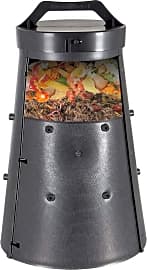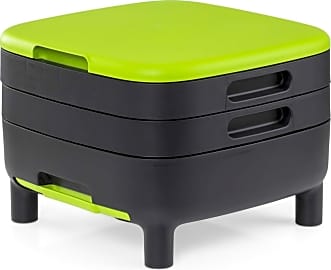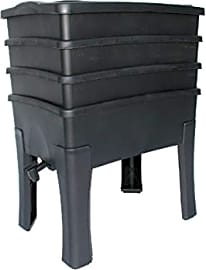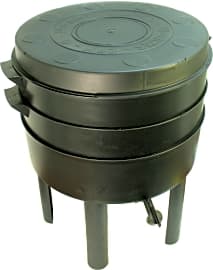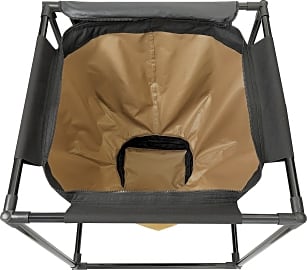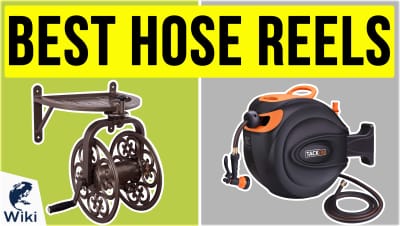The 7 Best Worm Composters

This wiki has been updated 37 times since it was first published in February of 2016. If you want to close the food cycle and enrich your garden, or set up a live-bait farming operation, vermiculture is the way to go. Fill one of these composters with fresh bedding, add a starter crop of cocoons or mature earthworms, feed them a healthy diet of kitchen scraps, and soon you'll have all the liquid fertilizer you need, plus plenty of bait for your next fishing trip. When users buy our independently chosen editorial picks, we may earn commissions to help fund the Wiki.
Editor's Notes
April 06, 2020:
While this round of updates had us remove the Worm Inn, Worm Box, Quest Farm, Hot Frog and Hungry Bin, all due to availability issues, we did also add two new additions to our list, which were the Riverstone Industries Maze Farm – a compact model that’s suitable for users that live by themselves and/or in small spaces, and the Tumbleweed Feast WF001 – a clever option that’s designed to be buried in your garden, allowing worms to aerate your soil when they’re not chowing down on your refuse.
A few things to think about while shopping in this category:
Capacity: The size of composter you’ll need depends entirely on the amount of waste you plan on processing. If you’re not sure how much waste you generate daily, a simple experiment you can do is saving up your compostable waste for a week, and dividing its total weight by seven.
As a general rule, worms can consume half their body weight every day. So, if you want to process one pound of waste daily, you’ll need to enlist the assistance of two pounds of worms, which amounts to 2,000 red wrigglers.
Since these worms like to feed in shallow soil, surface area is more important to them than depth, and 1,000 red wrigglers will require roughly one square foot of space to do their business. Some families generate significantly more than this, and for this reason many composters, such as the Can O Worms and Reln Garden Cafe employ stackable designs – not all that dissimilar to a Langstroth bee hive – that allow worms to access larger surface areas over a concentrated footprint.
Tea Extraction: In addition to using the “black-gold” casings that worms produce in their flowerbeds and vegetable gardens, many vermiculture enthusiasts will also use the spoils of their composters to brew nutrient-rich worm tea, which can be used as a natural fertilizer. Recognizing how useful this stuff is, and appreciating that worms require environments that are moist, but not too wet, to survive, many offerings on the market – such as the VermiHut System and Rain Garden Cafe – incorporate drainage systems into their designs, allowing gardeners to harvest this tea intermittently. The Riverstone Industries Maze Farm has an aerated base with a collection tray beneath it, but no tap – which is a bit less convenient.
Pest Defence: In theory, a properly balanced worm composter shouldn’t smell too much at all, since its population should be able to chew through the food you give it before it starts to rot. However, getting your composter dialed in isn’t always a wrinkle-free process, and with many users situating their composters close to their homes, or even indoors, many manufacturers have taken sensible steps to keep pests at bay. While the Tumbleweed Feast WF001 has a vermin-proof locking lid, the Reln Garden Cafe features tapered legs that ants have trouble crawling up.
Special Honors
United States Environmental Protection Agency If you're working with a shoestring budget, or you're just an unabashed do-it-yourselfer, building your own vermicomposter might be an option that interests you. This article from the USEPA breaks down the process in layman's terms, step by step. epa.gov
Uncle Jim's Worm Farm In addition to an online store offering several composters, this website features a blog full of useful articles for anybody who's breaking into the hobby, and a selection of live worms available for order – to help get your new project started. unclejimswormfarm.com
What To Look For In A Worm Composter
Most are perfectly designed for a garden or yard, but many can be equally as comfortable on a terrace or balcony.
When searching for a worm composter, there are a few things to keep in mind to ensure the best user experience and that you buy the highest-quality unit. One of the most important aspects to consider is the build quality. A poorly built container on nearly any type of product can be problematic, but when the container is housing thousands of worms and decaying food matter, it is even more important that it not be compromised in any manner.
It is also important to understand whether or not the system will come with worms. Compost requires a specific earthworm called Eisenia fetida, which has a different life-cycle and feeding pattern more conducive to compost than that of the typical earthworm. Where nightcrawlers or earthworms require soil to move through in order to fully live, Eisenia fetida thrives in areas rich in organic matter.
Another thing to consider is where the composter will be used. Most are perfectly designed for a garden or yard, but many can be equally as comfortable on a terrace or balcony. In some cases, people even put their composters directly in their kitchen with no problem, which, of course, requires that one buy a smaller unit that is very well-contained.
If you are one of the many people that know of the beneficial effects of worm tea, which is the liquid created by composting worms, a unit with a spigot to extract this compost tea is a smart idea. Choosing the right model comes down to having a good understanding of your particular needs, and finding a composter that has features which match those needs.
Benefits Of Worm Composters
Worm composter use is on the rise to help reduce the amount of food we waste. The Environmental Protection Agency has found that every single year, 133 million pounds of food is wasted, which is over 30 percent of all the food created in the country. This is a problem for those looking to conserve resources, and it directly impacts the amount of methane released into the atmosphere from landfills. By reducing the amount of food sent to landfills, much of this problem can be corrected. To reduce the amount of food waste, the EPA has set forth some guidelines in a food recovery hierarchy. A key aspect of this list is the use of composting to create nutrient-rich soil amendments out of food scraps. One of the easiest ways to do this is by setting up and utilizing a worm composter.
A key aspect of this list is the use of composting to create nutrient-rich soil amendments out of food scraps.
Many of the hurdles people quote as to why they cannot reduce their food waste by composting simply do not apply to worm composting. In many cases, these are actually the benefits of using a worm composter. For instance, opponents to composting say that the process smells foul. With a closed container worm composter, nothing could be further from the truth. The worms digest food scraps with no turning or rotating, and they do it quickly, so the food does not have time to rot.
People also seem to think that composting attracts rodents and roaches. While this is easily avoided through nuisance proofing, it is still seen as a hurdle. Luckily, worm composting kits are often in closed containers made of durable plastic. Many are also raised off the ground to prevent entry from common pests.
The most used excuse is the difficulty in starting the composting process and keeping it healthy. This argument goes out the window the second one realizes that worm composters themselves are very intuitive and extremely easy to use. If putting food scraps in a bin and closing a lid is too much work, a worm composter is not the right choice. However, after exuding that minimal effort, the worms do all the rest of the work.
Are Worm Composters Better Than Hot Composters?
The conversation of vermicomposting versus hot composting often comes up in very particular circles. When most people think of composting, what they are thinking of is the process of thermophilic, or hot composting. Thermophilic composting is as old as agriculture itself. The process creates heat through the metabolism of the millions of microbes in the compost heap. This self-heating process is enough to drive the temperature above 120 degrees Fahrenheit.
Namely, that worms are doing most of the composting along with bacteria.
Once this temperature is reached, a new class of bacteria goes to work. These bacteria can withstand the high temperatures needed to help break down food scraps rapidly. Their own metabolic processes take the temperature further; piles often reach 170-180 degrees before running out of food for the bacteria. Once the matter is fully broken down, the bacterial metabolism slows, cooling the pile down and curing the compost into its most usable form. The rich smelling, dark brown to black soil amendment produced is high in soluble nutrients, which can be carried to the cells of plants to help their growth cycle. The basic pros of hot compost are that it kills weed seeds and harmful pathogens, and can break down compost quickly in ideal conditions. The cons are mainly that it is labor intensive, and that heating material can lead to nitrogen loss
With vermicomposting, or worm composting, this same soil amendment is produced with a twist. Namely, that worms are doing most of the composting along with bacteria. Both of the processes help oxidize organic wastes and turn them into nutrients, they just do so differently. Worm composting is a much cooler process, and is considered a continuous approach. Unlike hot compost, which requires composting in batches, worm composting can be added a little at a time; such as adding the food scraps from a meal every day.
Compost created this way is less labor intensive, and the cooler temperatures help to conserve nitrogen better than in hot composters. It also produces the previously mentioned byproduct, worm tea, which can be a beneficial to plants when added to soil. The cons of the system are that it will not kill weed seeds, and that care has to be taken to avoid killing the worms with temperature extremes or too much compost.
Because of the varying benefits, the best choice between the two is quite situational. For instance, in a situation where weeds will be composted, a hot composter will help to kill their seeds. But if it is nitrogen that the user is after, a worm composter is king.



